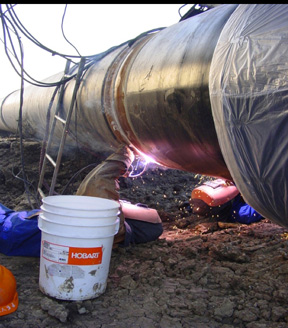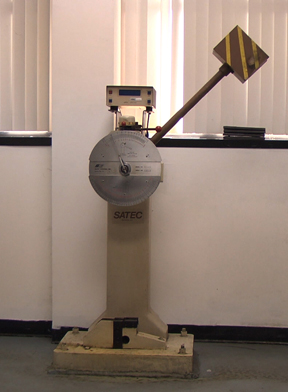The Impact of Impact Toughness: What You Should Know About Filler Metals and More
When choosing filler metals, finding those with the right mechanical and chemical properties for the application is critical. Correct properties not only ensure the proper weld strength, but may also help prevent costly complications.
In applications that endure rapid or cyclic loading, experience extreme service temperatures or are subject to other stressors that threaten the integrity of the weld — seismic activity, for example — using a filler metal that provides the proper impact toughness is especially important. In particular, high-strength low-alloy materials can benefit from these filler metals, as can some mild-steel applications.
What is impact toughness and why is it important?
Impact toughness is the ability of a weld to permanently deform and absorb energy before fracturing — specifically when stress/strain has been applied to it rapidly (typically, in under one second). In simpler terms: it’s how much rapid impact energy a weld can take before it cracks. Impacts can come in the form of natural elements (wind, earthquakes, etc.), explosions, collisions, rapid loading and more.

toughness is especially important to protect against
cracking or catastrophic weld failure in certain
applications.
Filler metals that provide good impact toughness can help minimize the extent and rate of cracking should it occur as the result of an impact or fatigue from cyclic loading. In low service temperature applications, such filler metals can also help mitigate the risk of brittle fractures caused by the loss of toughness that steels experience at sub-zero temperatures. In some cases, good impact toughness in a weld can even arrest the propagation of a crack, allowing for emergency repairs to occur prior to catastrophic failure of the component.
The best-case scenario, however, is that using filler metals with good impact toughness — combined with consistent and appropriate welding procedures — can help prevent cracking altogether. There are many codes and specifications that require the use of filler metals capable of meeting minimum impact toughness for this very reason.
Most filler metal manufacturers formulate, classify and produce filler metals according to strict standards, such as the American Welding Society (AWS) A5 filler metal specifications. These specifications provide minimum impact toughness requirements for each filler metal classification, as well as the method by which these electrodes should be tested.
Fabricators may select filler metal classifications based on the requirements stated in the code or specification for their application. One such example is the AWS D1.8 Structural Welding Code – Seismic Supplement, which was developed to help ensure safety in demand-critical applications, such as structures constructed in seismic areas. Fabricators should be aware that code or specification requirements may exceed the toughness requirements given in a filler metal specification.
In other cases, engineers may have some discretion over the filler metal impact toughness requirements for a filler metal for a given welding procedure. Engineers develop requirements in a way that can account for expected service conditions, as well as any foreseeable misuse or abuse. For example, a bridge engineer may design welds to be able to withstand a boat collision. This structure, of course, was not intended for such an occurrence, but filler metals with high impact toughness can help ensure the ability to safely withstand such unexpected impacts.
How do filler metals provide impact toughness?
Filler metal manufacturers formulate products using a delicate balance of many elements, each of which provides distinct characteristics to both the welding process and the completed weld. These elements can range from deoxidizers that can weld through mill scale or the addition of chrome to increase corrosion resistance. When designing filler metals to provide good impact toughness, the addition of nickel, and the elimination of phosphorous and sulfur are particularly helpful.
Nickel can improve the properties of weld metal by altering its microstructure in a way that increases strength and offers good resistance to cracking. In some cases, wires with added nickel may have a slightly more sluggish weld puddle and/or generate additional spatter, but the increased toughness properties generally offsets such disadvantages.
The presence of phosphorous and sulfur, in both the filler and base metals is especially detrimental to weld toughness. The harmful effects of these elements are amplified in single-pass applications where more of the base metal mixes with the filler metal, increasing the chance for weld metal to pick these elements up from the base metal. To ensure good impact toughness, it is best to select both base and filler metals with as low of a phosphor and sulfur content as possible, ideally no more than 0.03 percent.
Comparing AWS classifications is a good starting point when selecting filler metals for impact toughness. E7018-1 shielded metal arc welding (SMAW) electrodes provide improved impact toughness over plain E7018 electrodes. When selecting gas-shielded flux-cored arc welding (FCAW) wires, T-9 electrodes (ex. E71T-9 C/M) are as easy to control during the welding process as T-1 electrodes, but offer better toughness. T-5 FCAW wires are an even tougher option. They can be bit more difficult to weld with, but the impact properties they provide are excellent and often make the less-than-optimal operating characteristics worthwhile. These electrodes are typically the first recommendation in many critical applications and repairs.
If in doubt, consult with a trusted filler metal manufacturer or distributor to determine the best filler metal for each application.

to determine impact toughness in filler metals
and is considered the industry standard. A
computer calculates the CVN impact value by
measuring the highest point of the pendulum
after contacting the weld.
The Charpy V-notch test: measuring impact toughness in filler metals
The Charpy V-notch (CVN) test is one of several tests to determine impact toughness in filler metals and is considered the industry standard. The equipment to complete the test consists of a hammer located at the end of a pendulum. After being released from a set height, the force of the hammer applies a consistent amount of energy to the weld specimen (held inside a special jig) and typically breaks a precision-machined notched specimen as it continues on its fixed path. A computer calculates the CVN impact value by measuring the highest point of the pendulum after contacting the weld.
Impact toughness values are shown in terms of foot-pounds and joules — units of energy absorbed — at a given temperature (ex. 20 ft-lbs @ -20°F). The temperature at which filler metals are tested for impact toughness varies according to their individual classifications. Most mild steel filler metals undergo testing between zero and -40 degrees Fahrenheit, while some low alloy products must be tested at temperatures as low as -150 degrees Fahrenheit. Again, steel loses toughness at low temperatures, so it is especially important to consider the test temperature of the filler metal when it will be used in sub-zero applications.
Fabricators should also know that a CVN test is not an exact simulation of how their structure will respond to a real-life impact scenario. Still, the test offers a sufficient comparison for weld and base metal performance, and most welding codes and specifications support the measurements that the test provides.
What other factors affect impact toughness?
In conjunction with choosing the correct filler metals, welding procedures (particularly temperature control) and shielding gases can affect the impact toughness in a completed weld.
Pre-heating the base material before welding — and maintaining proper interpass temperatures during welding — can help to slow the cooling rate of both the base and weld metal after welding. A slower cooling rate helps minimize issues with the metal structure on a microscopic level that can negatively affect impact toughness.
Fabricators should also take care to control the heat input during the welding process, regardless of whether they are welding single- or multi-pass applications. Like preheat, a higher heat input can help slow the cooling rate and help prevent cracks. However, excessive heat input can cause a host of other problems that will eventually minimize toughness, including the generation of a larger heat affected zone (HAZ), which is particularly detrimental for quenched and tempered (Q&T) steels. Too high of heat input can also alter the filler metal deposit chemistry, causing certain elements to “burn out” of the weld and therefore, lessen its impact toughness.
Post-weld heat treatment (PWHT) operations, such as stress relieving can also affect impact toughness of the weldment. The decision to carry out these operations should always be at the discretion of the engineer, in conjunction with welding code requirements. Likewise, filler metal manufacturers should be consulted prior to the use of PWHT with their products to ensure that the chosen filler metal will maintain acceptable properties following a PWHT operation.
Finally, always use the manufacturer-recommended shielding gas for a filler metal to obtain the correct impact toughness. Different shielding gas compositions have unique reactions with the weld pool that affect mechanical and chemical properties differently. Filler metal manufacturers are aware of these interactions and carefully adjust formulations to provide optimum impact toughness for intended shielding gases.
Product data sheets provide shielding gas and welding parameter information and fabricators should always consult them; filler metal manufacturers have an intended operating window for each product to prevent compromising vital filler metal characteristics.
As long as fabricators adhere to correct welding procedures appropriate to filler metal manufacturer recommendations, they should be able to achieve the weld performance that is consistent with the filler metal’s classification – including its impact toughness.



